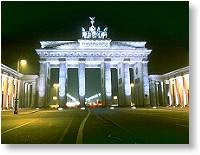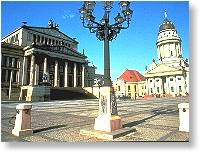|
Now the capital of Germany again, the
energy of progress, supported by billions of Marks, is changing the face
of Berlin. At the heart of this leafy city, criss-crossed with rivers
and canals, is the Reichstag, the old parliament building, centrepiece
of the new German capital, and the grandiose Brandenburg Gate.
The Brandenburg Gate (pictured upper left) leads to the parts of Eastern Berlin that have almost regained their pre-war elegance: Unter den Linden, a broad, stately boulevard, the Frederick the Great statue, the Alte Bibliothek, St Hedwig's Cathedral, and the flawless Deutsche Staatsoper. At the Potsdamer Platz there is a vast new shopping mall and huge investment has poured in by corporations; to the north a small hummock marks the remains of Hitler's bunker. Few vestiges of the wall, built in 1961, remain and Checkpoint Charlie was destroyed. The museum at Haus am Checkpoint Charlie records the wall's chilling history. One of the most monumental structures in Eastern Berlin is the gigantic Fernsehturm or TV tower with an observation platform for unbeatable views and Alexanderplatz is the commercial and shopping hub of the former Soviet sector. In Western Berlin, the Kurfürstendamm or Ku'damm, is a 3.5km strip of ritzy shops, cinemas, bars and cafés where you can check the throbbing pulse of the city. Berlin boasts an admirable collection of museums: the Zoologischer Garten forms the beginning of the Tiergarten, a restful expanse of woodland where there is a series of museums centred on the Neue Nationalgalerie. The great museums of eastern Berlin are centred on the Museuminsel, and include the Pergamonmuseum and the Bodemuseum. |



